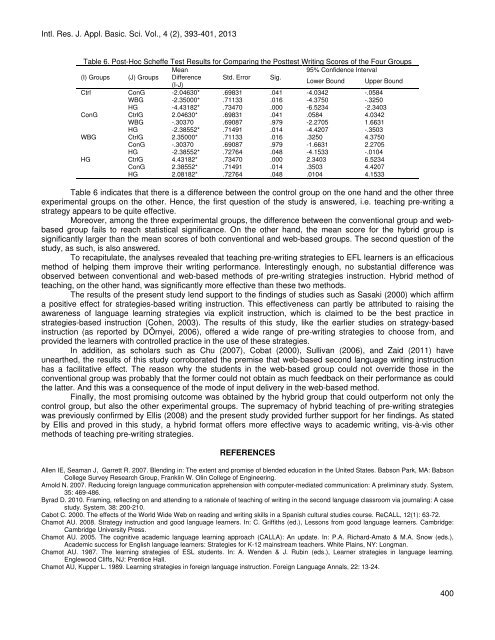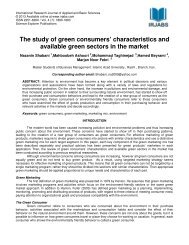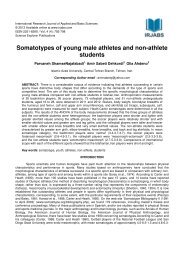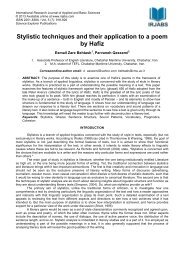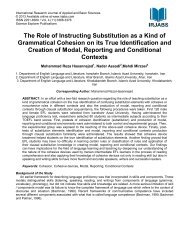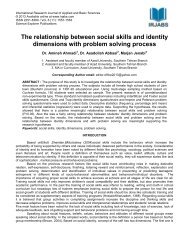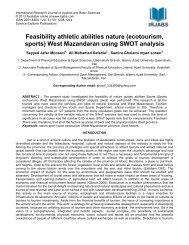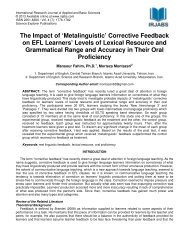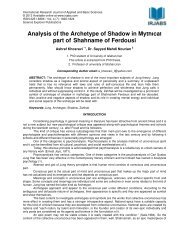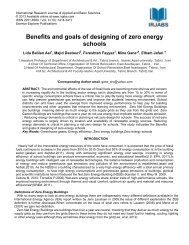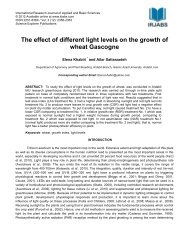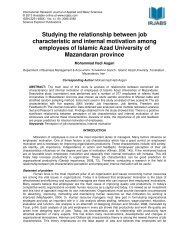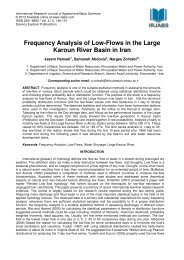Intl. Res. J. Appl. Basic. Sci. Vol., 4 (2), 393-401, 2013Table 6. Post-Hoc Scheffe Test Results for Comparing the Posttest Writing Scores <strong>of</strong> the Four GroupsMean95% Confidence Interval(I) Groups (J) Groups Difference Std. Error Sig.(I-J)Lower Bound Upper BoundCtrlConGWBGHG-2.04630*-2.35000*-4.43182*.69831.71133.73470.041.016.000-4.0342-4.3750-6.5234-.0584-.3250-2.3403ConGWBGHGCtrlGWBGHGCtrlGConGHGCtrlGConGHG2.04630*-.30370-2.38552*2.35000*-.30370-2.38552*4.43182*2.38552*2.08182*.69831.69087.71491.71133.69087.72764.73470.71491.72764.041.979.014.016.979.048.000.014.048.0584-2.2705-4.4207.3250-1.6631-4.15332.3403.3503.01044.03421.6631-.35034.37502.2705-.01046.52344.42074.1533Table 6 indicates that there is a difference between the control group on the one h<strong>and</strong> <strong>and</strong> the other threeexperimental groups on the other. Hence, the first question <strong>of</strong> the study is answered, i.e. teaching pre-writing astrategy appears to be quite effective.Moreover, among the three experimental groups, the difference between the conventional group <strong>and</strong> web<strong>based</strong>group fails to reach statistical significance. On the other h<strong>and</strong>, the mean score for the hybrid group issignificantly larger than the mean scores <strong>of</strong> both conventional <strong>and</strong> web-<strong>based</strong> groups. <strong>The</strong> second question <strong>of</strong> thestudy, as such, is also answered.To recapitulate, the analyses revealed that teaching pre-writing strategies to EFL learners is an efficaciousmethod <strong>of</strong> helping them improve their writing performance. Interestingly enough, no substantial difference wasobserved between conventional <strong>and</strong> web-<strong>based</strong> methods <strong>of</strong> pre-writing strategies instruction. <strong>Hybrid</strong> method <strong>of</strong>teaching, on the other h<strong>and</strong>, was significantly more effective than these two methods.<strong>The</strong> results <strong>of</strong> the present study lend support to the findings <strong>of</strong> studies such as Sasaki (2000) which affirma positive effect for strategies-<strong>based</strong> writing instruction. This effectiveness can partly be attributed to raising theawareness <strong>of</strong> language learning strategies via explicit instruction, which is claimed to be the best practice instrategies-<strong>based</strong> instruction (Cohen, 2003). <strong>The</strong> results <strong>of</strong> this study, like the earlier studies on strategy-<strong>based</strong>instruction (as reported by DÖrnyei, 2006), <strong>of</strong>fered a wide range <strong>of</strong> pre-writing strategies to choose from, <strong>and</strong>provided the learners with controlled practice in the use <strong>of</strong> these strategies.In addition, as scholars such as Chu (2007), Cobat (2000), Sullivan (2006), <strong>and</strong> Zaid (2011) haveunearthed, the results <strong>of</strong> this study corroborated the premise that web-<strong>based</strong> second language writing instructionhas a facilitative effect. <strong>The</strong> reason why the students in the web-<strong>based</strong> group could not override those in theconventional group was probably that the former could not obtain as much feedback on their performance as couldthe latter. And this was a consequence <strong>of</strong> the mode <strong>of</strong> input delivery in the web-<strong>based</strong> method.Finally, the most promising outcome was obtained by the hybrid group that could outperform not only thecontrol group, but also the other experimental groups. <strong>The</strong> supremacy <strong>of</strong> hybrid teaching <strong>of</strong> pre-writing strategieswas previously confirmed by Ellis (2008) <strong>and</strong> the present study provided further support for her findings. As statedby Ellis <strong>and</strong> proved in this study, a hybrid format <strong>of</strong>fers more effective ways to academic writing, vis-à-vis othermethods <strong>of</strong> teaching pre-writing strategies.REFERENCESAllen IE, Seaman J, Garrett R. 2007. Blending in: <strong>The</strong> extent <strong>and</strong> promise <strong>of</strong> blended education in the United States. Babson Park, MA: BabsonCollege Survey Research Group, Franklin W. Olin College <strong>of</strong> Engineering.Arnold N. 2007. Reducing foreign language communication apprehension with computer-mediated communication: A preliminary study. System,35: 469-486.Byrad D. 2010. Framing, reflecting on <strong>and</strong> attending to a rationale <strong>of</strong> teaching <strong>of</strong> writing in the second language classroom via journaling: A casestudy. System, 38: 200-210.Cabot C. 2000. <strong>The</strong> effects <strong>of</strong> the World Wide <strong>Web</strong> on reading <strong>and</strong> writing skills in a Spanish cultural studies course. ReCALL, 12(1): 63-72.Chamot AU. 2008. Strategy instruction <strong>and</strong> good language learners. In: C. Griffiths (ed.), Lessons from good language learners. Cambridge:Cambridge University <strong>Pre</strong>ss.Chamot AU. 2005. <strong>The</strong> cognitive academic language learning approach (CALLA): An update. In: P.A. Richard-Amato & M.A. Snow (eds.),Academic success for English language learners: Strategies for K-12 mainstream teachers. White Plains, NY: Longman.Chamot AU. 1987. <strong>The</strong> learning strategies <strong>of</strong> ESL students. In: A. Wenden & J. Rubin (eds.), Learner strategies in language learning.Englewood Cliffs, NJ: <strong>Pre</strong>ntice Hall.Chamot AU, Kupper L. 1989. Learning strategies in foreign language instruction. Foreign Language Annals, 22: 13-24.400
Intl. Res. J. Appl. Basic. Sci. Vol., 4 (2), 393-401, 2013Chuo TI. 2007. <strong>The</strong> effect <strong>of</strong> the <strong>Web</strong>Quest writing instruction program on EFL learners’ writing performance, writing apprehension, <strong>and</strong>perception. TESL-EJ, 11(3): 1-27.Cohen A. 2003. Strategy training for second language learners. Washington, DC: ERIC Clearinghouse on Languages <strong>and</strong> Linguistics. (ERICDocument Reproduction Service No. ED482492).Cohen A. 1998. Strategies in learning <strong>and</strong> using a second language. London: Longman.Cohen A. 1990. Language learning: Insights for learners, teachers, <strong>and</strong> researchers. New York: Newbury House.Cohen A, DÖrnyei Z. 2002. Focus on the language learner: Motivation, styles, <strong>and</strong> strategies. In: N. Schmitt (ed.), An introduction to appliedlinguistics. London: Arnold.Cresswell A. 2000. Self-monitoring in student writing: Developing responsibility. ELT Journal, 3: 235-244.Cumming A. 1995. Fostering writing expertise in ESL composition instruction: Modeling <strong>and</strong> Evaluation. In: D. Belcher <strong>and</strong> G. Braine (Eds.),Academic writing in a second language. Norwood, NJ: Ablex Publishing Co.Cumming A, So S. 1996. Tutoring second language text revision: Does the approach to instruction or the language <strong>of</strong> communication make adifference? Journal <strong>of</strong> Second Language Writing, 5: 197-226.DÖrnyei Z. 2006. Individual differences in second language acquisition. AILA Review, 19: 42-68.Dziuban CD, Hartman JL, Moskal PD. 2004. Blended learning. Educause, 7: 1-12.Ellis LV. 2008. Writing instruction <strong>and</strong> learning strategies in a hybrid EAP course: A case study with college-bound ESL students. Unpublisheddoctoral dissertation, Walden University, Minneapolis, MN.Grenfell M, Harris V. 1999. Modern languages <strong>and</strong> learning strategies: In theory <strong>and</strong> practice. London: Routledge.Griffiths C. 2008. Strategies <strong>and</strong> good language learners. In: C. Griffiths (ed.), Lessons from good language learners. Cambridge: CambridgeUniversity <strong>Pre</strong>ss.Hacker DJ, Keener N C, Kircher JC. 2009. Writing is applied metacognition. In: D. J. Hacker, J. Dunlosky, & A. Graesser (eds.), H<strong>and</strong>book <strong>of</strong>metacognition in education. New York, NY: Routledge.Hedgcock JS. 2005. Taking stock <strong>of</strong> research <strong>and</strong> pedagogy in L2 writing. In: E. Hinkel (ed.), H<strong>and</strong>book <strong>of</strong> research in second languageteaching <strong>and</strong> learning. Mahwah, NJ: Lawrence Erlbaum Associates.Kroll B. 2001. Considerations for teaching an ESL/EFL writing course. In: M. Celce-Murcia (ed.), <strong>Teaching</strong> English as a second or foreignlanguage. Boston, MA: Heinle & Heinle.McCrory RS. 2006. Technology <strong>and</strong> teaching: A new kind <strong>of</strong> knowledge. In: E. A. Ashburn & R. E. Floden (eds.), Meaningful learning usingtechnology (pp. 141- 160). New York: Teachers College, Columbia University.Mekheimer M. 2005. <strong>Effect</strong>s <strong>of</strong> Internet-<strong>based</strong> Instruction, Using <strong>Web</strong>questing <strong>and</strong> Emailing on Developing Some Essay Writing Skills inStudent Teachers. Unpublished doctoral dissertation, Cairo University.Nunan D. 1989. Designing tasks for the communicative classroom. Cambridge: Cambridge University <strong>Pre</strong>ss.Nunan D. 1999. Second language teaching <strong>and</strong> learning. Boston, MA: Heinle & Heinle.Oliver R, Harrington J. 2003. Exploring technology-mediated learning from a pedagogical perspective. Interactive Learning Environments, 11(2):111-126.Olshtain E. 2001. Functional tasks for mastering the mechanics <strong>of</strong> writing <strong>and</strong> going just beyond. In: M. Celce-Murcia (ed.), <strong>Teaching</strong> Englishas a second or foreign language. Boston, MA: Heinle & Heinle.O’ Mally JM, Chamot AU, Stewner,-Manzanares G, Kupper L, Russo R. 1985. Learning strategy applications with students <strong>of</strong> English as asecond language. TESOL Quarterly, 19: 285-296.Oxford R. 1990. Language learning strategies: What every teacher should know. Rowley, Mass: Newbury House.Polio C, Williams J. 2009. <strong>Teaching</strong> <strong>and</strong> testing writing. In: M. H. Long & C. J. Doughty (eds.), <strong>The</strong> h<strong>and</strong>book <strong>of</strong> language teaching. Malden,MA: Blackwell Publishing.Ransdell S, Lavelle B, Levy M. 2002. <strong>The</strong> effects <strong>of</strong> training a good working memory strategy on L1 <strong>and</strong> L2 writing. In: S. Ransdell & M.L.Barbiere (eds.), New directions for research in L2 writing. Dordrecht: Kluwer Academic Publishers.Richards JC. 1990. <strong>The</strong> language teaching matrix. Cambridge: Cambridge University <strong>Pre</strong>ss.Richards JC, Ren<strong>and</strong>ya WA. 2002. Methodology in language teaching: An anthology <strong>of</strong> current practice. Cambridge: Cambridge University<strong>Pre</strong>ss.Rivers WM. 1981. <strong>Teaching</strong> foreign language skills. 2 nd edn. Chicago: <strong>The</strong> Univesity <strong>of</strong> Chicago <strong>Pre</strong>ss.Rovai AP, Jordan HM. 2004. Blended learning <strong>and</strong> sense <strong>of</strong> community: A comparative analysis with traditional <strong>and</strong> fully online graduatecourses. <strong>The</strong> International Review <strong>of</strong> Research in Open <strong>and</strong> Distance Learning, 5(2): 1-13.Rubin J. 1987. Learner strategies: <strong>The</strong>oretical assumptions, research history ans typology. In: A. Wenden, A. <strong>and</strong> J. Rubin (eds), Learnerstrategies in language learning. London: <strong>Pre</strong>ntice Hall International.Sasaki M. 2000. Toward an empirical model <strong>of</strong> EFL writing processes: An exploratory study. Journal <strong>of</strong> Second Language Writing, 9(3): 259-291.Sengupta S. 2000. An investigation into the effects <strong>of</strong> revision strategy instruction on L2 secondary school learners. System, 28(1): 97-113.Serdyukov P, Hill R. 2004, November. Masonry <strong>of</strong> e-learning: Managing knowledge construction <strong>and</strong> skill development in an online course.Proceedings <strong>of</strong> E-Learn Worlds Conference on E-Learning in Corporate, Government, Healthcare& Higher education, Washington, D.C.Silva T, Matsuda PK. 2002. Writing. In: N. Schmitt (ed.), An introduction to applied linguistics . New York, NY: Arnold Publishers.Sotillo S. M. 2000. Discourse functions <strong>and</strong> syntactic complexity <strong>of</strong> synchronous <strong>and</strong> asynchronous communication. Language Learning <strong>and</strong>Technology, 4(1): 82-119.Sullivan IO. 2006. Learners’ writing skills in French: Corpus consultation <strong>and</strong> learner evaluation. Journal <strong>of</strong> Second Language Writing, 15(1): 49-68.Tarone E. 1980. Communication strategies, foreigner talk, <strong>and</strong> repair in interlanguage. Language Learning, 30: 417-431.Tu CH. 2005. From presentation to interaction: New goals for online learning technologies. Educational Media International, 42(3): 189-206.Zaid MA. 2011. <strong>Effect</strong>s <strong>of</strong> web-<strong>based</strong> pre-writing activities on college EFL students’ writing performance <strong>and</strong> their writing apprehension. Journal<strong>of</strong> King Saud University – Languages <strong>and</strong> Translation, 23(2): 77-85.Zamel V. 1985. Responding to student writing. TESOL Quarterly, 19(1): 79-102.Zhu W. 2004. Faculty views on the importance <strong>of</strong> writing, nature <strong>of</strong> academic writing, <strong>and</strong> teaching <strong>and</strong> responding to writing in disciplines.Journal <strong>of</strong> Second Language Writing, 13: 29-48.401


